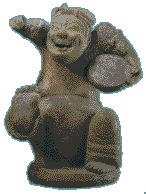


 silk
textiles and lacquerware, which were found in tombs but
which the deceased may have also used in life. The
life-sized terra-cotta soldier from the Qin dynasty
(221-207 BCE) is also mingqi but is
exceptional in its large scale. More common in the Han
and Tang dynasties were the reduced-scale images that
appear in this section.
silk
textiles and lacquerware, which were found in tombs but
which the deceased may have also used in life. The
life-sized terra-cotta soldier from the Qin dynasty
(221-207 BCE) is also mingqi but is
exceptional in its large scale. More common in the Han
and Tang dynasties were the reduced-scale images that
appear in this section.
The emergence of mingqi indicates a shift in the conception of the afterlife to an extension and idealization of the earthly life of the deceased-a reflection of earthly status and a perfection of earthly pleasures. Figures of attendants, guards, entertainers, and pets, along with models of buildings, household furnishings, carriages, carts, and draft animals, transformed the silent tomb into a lively setting for the afterlife, as similar as possible to the living world of the elite. Mingqi also served the centuries-old practice of demonstrating filial piety and, at the same time, family wealth and status, by lavishing resources on the burial of relatives.